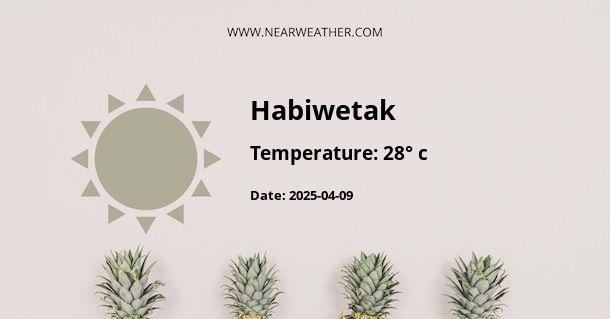Climate and Weather in Habiwetak, ID
Habiwetak, ID, is known for its diverse climate and stunning landscapes. Located in the northern part of the state, Habiwetak experiences a unique blend of weather patterns throughout the year. Understanding the climate and weather in Habiwetak is essential for residents and visitors alike, as it can greatly impact outdoor activities, agriculture, and overall lifestyle.
Seasonal Weather Patterns
Like many areas in the northern United States, Habiwetak experiences distinct seasonal changes, with each season bringing different weather conditions.
Spring
In spring, Habiwetak begins to emerge from the cold winter months. The average temperatures in March range from 35°F to 52°F, gradually warming up to 44°F to 64°F in May. Spring is characterized by blooming wildflowers and the gradual thawing of winter snow, making it an ideal time for outdoor exploration.
Summer
Summer in Habiwetak brings warm and pleasant weather, with average temperatures ranging from 53°F to 81°F. The region experiences long daylight hours, providing ample opportunities for outdoor recreational activities such as hiking, camping, and fishing.
Fall
As fall sets in, Habiwetak showcases stunning foliage as the leaves of deciduous trees transition to vibrant shades of red, orange, and yellow. Average temperatures in September range from 40°F to 68°F, gradually cooling down to 30°F to 53°F in November.
Winter
Winter in Habiwetak brings cold and snowy conditions, with average temperatures ranging from 18°F to 31°F. The region transforms into a winter wonderland, offering opportunities for skiing, snowboarding, and other snow-related activities.
Precipitation and Annual Weather Patterns
Habiwetak experiences moderate levels of precipitation throughout the year, with the highest levels typically occurring in the spring and winter months. Annual precipitation averages around 25 inches, providing essential moisture for the region's ecosystem and agricultural activities.
Annual Weather Averages
To provide a comprehensive overview of Habiwetak's climate, here are the annual weather averages for the region:
| Month | High (°F) | Low (°F) | Precipitation (inches) |
|---|---|---|---|
| January | 32 | 15 | 2.1 |
| February | 36 | 18 | 1.8 |
| March | 45 | 25 | 2.3 |
| April | 56 | 33 | 1.9 |
| May | 65 | 41 | 2.4 |
| June | 74 | 48 | 1.7 |
| July | 82 | 53 | 0.7 |
| August | 81 | 51 | 0.8 |
| September | 71 | 42 | 1.6 |
| October | 59 | 34 | 2.0 |
| November | 43 | 26 | 1.9 |
| December | 34 | 17 | 2.3 |
These weather averages provide valuable insights into the fluctuating climate of Habiwetak throughout the year. The data illustrates the gradual transition from cold winters to warm summers, with variations in precipitation levels influencing the overall weather patterns.
Extreme Weather Events
While Habiwetak generally experiences mild weather, the region is susceptible to occasional extreme weather events. These events can include heavy snowstorms in winter or thunderstorms in the summer, which may impact local infrastructure and outdoor activities.
It is important for residents and visitors to stay informed about weather forecasts and advisories, especially during periods of potential extreme weather, to ensure safety and preparedness.
Conclusion
Habiwetak, ID, offers a diverse and ever-changing climate, with each season presenting its own unique beauty and weather patterns. From the vibrant blooms of spring to the snowy landscapes of winter, Habiwetak's climate contributes to its rich natural environment and outdoor recreational opportunities. Understanding the weather and climate of Habiwetak is essential for making the most of what this picturesque region has to offer.
A - Habiwetak's Latitude is -8.654700 & Longitude is 122.244698.
A - Weather in Habiwetak is 26° today.
A - Climate Conditions in Habiwetak shows overcast clouds today.
A - Humidity in Habiwetak is 83% today.
A - Wind speed in Habiwetak is 7.7 km/h, flowing at 194° wind direction. today.
